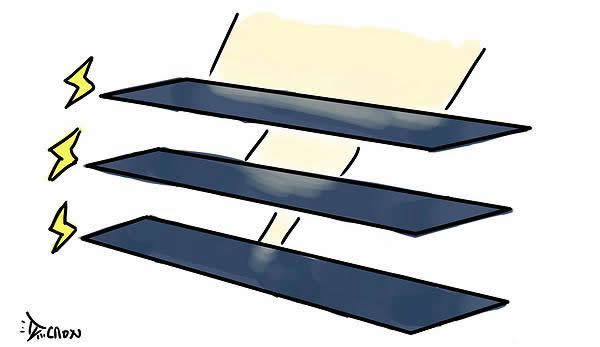Solar cells that capture most of the solar spectrum
Scientists have designed and built prototypes of a new type of solar cell that stacks multiple cells into a single device that captures almost all of the energy in the solar spectrum. This new design converts sunlight to electricity with an efficiency of 44.5% and is expected to become an efficient solar cell in the world.
This method is different from the kind of solar panels that are commonly seen on the roof or in fields. This new device uses a concentrator photovoltaic (CPV) panel that uses a lens to focus sunlight on tiny-scale solar cells. Due to its small size, less than 1 square millimeter, solar cells with more complex materials can be effectively developed.

Stacked batteries are like solar screens, where each layer of specially crafted material absorbs a specific set of wavelengths of energy. When sunlight passes through the entire stack, nearly half of the available energy is converted to electricity. In contrast, most common solar cells can only convert 25% of the available energy into electricity.
The study's lead author, Matthew Lumb, a research scientist at the George Washington University School of Engineering and Applied Science, said: "99% of the sunlight reaching the earth's surface falls within the wavelength range of 250 to 2500 nanometers, but highly efficient multi-junction solar cells The traditional materials cannot capture this entire spectral range.Our new device can unlock the energy stored in long-wavelength photons, which are not captured by traditional solar cells, thus providing a path to achieve multi-connected solar cells. â€
Although scientists have been working hard for more efficient solar cells for many years, this method has two innovations. First, the method utilizes a family of gallium arsenide (GaSb) based materials, which are common in applications such as infrared lasers and photodetectors. This new type of cesium telluride-based solar cells is assembled into a stacked structure while growing high-efficiency solar cells on traditional substrates that capture shorter wavelengths of sunlight. In addition, the stacking process uses a technology called transfer, which can three-dimensionally assemble these tiny devices with high precision.
This kind of solar cell is very expensive, but the researchers believe that the most important thing is to show the upper limit of efficiency that can be achieved. Although the materials used are expensive, the technology used to make such batteries is promising. By reducing costs and recycling these growing substrates, similar products in the future may be marketed.
Multi-Size Elastic Rubber Band,Molded Rubber,Epdm O-Rings,Customized Silicone Rubber Gasket
Ningbo Yongsheng Rubber And Plastic Products Co., Ltd. , https://www.yscnrubber.com